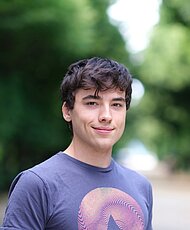An important fundamental issue in all previous Bell experiments is the quality of the random numbers, which are used to decide the setting parameter on both photons independently. In our “loophole-free” experiment [1], we did this with high quality random number generators [2], which, to the best of our knowledge, are among the best random number generators currently available. Yet, as has been pointed out in the early days of this experiment, such random number generators could in principle still be influenced by some very recent event in their common past. In that sense, it is important to look for the most independent possible sources of randomness available in the Universe.
It has been suggested very early to use the light from quasars at opposite locations in the sky to choose between the different measurement settings in a Bell experiment and a related explicit proposal for such a “Cosmic Bell” test was published in 2014 [3]. One of the ideas is to push back the most recent time by which any local-realist influences could have engineered the observed Bell violation.
In 2017 our group reported on the first experimental implementation of the proposed „Cosmic Bell“ test [4]. In this experiment, we performed tests with polarisation-entangled photons while using Milky Way stars as “cosmic setting generators” approximately 600 lightyears away.
In a recent experiment [5] that we performed on the Canary island of La Palma together with various international partners, we successfully made another important step back in time. In a setup similar to the previous experiment, we performed tests with polarisation-entangled photons that where sent in beams through the air. For this experiment, we used two 4m class telescopes for real-time observations of distant quasars in opposite directions of the sky. The measurement settings were then chosen based on the colour of the quasar photons. While we simultaneously ensured locality we assumed fair sampling for all detected photons, and that each cosmic photon’s colour was set at emission. We observed statistically significant violations of Bell’ inequality, thereby pushing the most recent time by which any local-realist influences could have engineered the observed Bell violation by more than 7.8 billion years.
Future experiments could aim for even more distant signals. One can even think of using other sources like the cosmic microwave background, primordial gravitational waves or even neutrinos. A different route is to conduct a "loophole free" Cosmic Bell test or two check even stronger correlations from multiple particles or in multiple dimensions.

[1] M. Giustina, M. A. M. Versteegh, S. Wengerowsky, J. Handsteiner, A. Hochrainer, K. Phelan, F. Steinlechner, J. Kofler, J.-Å. Larsson, C. Abellán, W. Amaya, V. Pruneri, M. W. Mitchell, J. Beyer, T. Gerrits, A. E. Lita, L. K. Shalm, S. W. Nam, T. Scheidl, R. Ursin, B. Wittmann, and A. Zeilinger, Significant-Loophole-Free Test of Bell’s Theorem with Entangled Photons, Phys. Rev. Lett. 115, 250401 (2015).
[2] M. W. Mitchell, C. Abellan, W. Amaya, Strong experimental guarantees in ultrafast quantum random number generation, Phys. Rev. A 91, 012314 (2015).
[3] J. Gallicchio, A. S. Friedman, D. I. Kaiser, Testing Bell’s Inequality with Cosmic Photons: Closing the Setting-Independence Loophole, Phys. Rev. Lett. 112, 110405 (2014).
[4] J. Handsteiner, A. S. Friedman, D. Rauch, J. Gallicchio, B. Liu, H. Hosp, J. Kofler, D. Bricher, M. Fink, C. Leung, A. Mark, H. T. Nguyen, I. Sanders, F. Steinlechner, R. Ursin, S. Wengerowsky, A. H. Guth, D. I. Kaiser, T. Scheidl, and A. Zeilinger, Cosmic Bell Test: Measurement Settings from Milky Way Stars, Phys. Rev. Lett. 118, 060401 (2017).
[5] D. Rauch, J. Handsteiner, A. Hochrainer, J. Gallicchio, A. S. Friedman, C. Leung, B. Liu, L. Bulla, S. Ecker, F. Steinlechner, R. Ursin, B. Hu, D. Leon, C. Benn, A. Ghedina, M. Cecconi, A. H. Guth, D. I. Kaiser, T. Scheidl and A. Zeilinger, Cosmic Bell Test Using Random Measurement Settings from High-Redshift Quasars, Phys. Rev. Lett. 121, 080403 (2018)
Zeilinger Group

Anton Zeilinger
Gruppenleiter+43 (1) 51581 - 9512

Amin Babazadeh
Postdoktorand (Univie)

Matthias Estermann
Master Student

Xinhe Jiang
Postdoktorand

Alois Mair
Senior Postdoktorand

